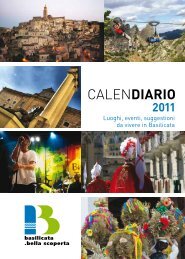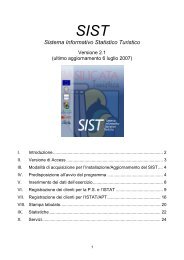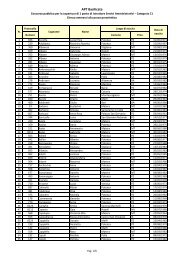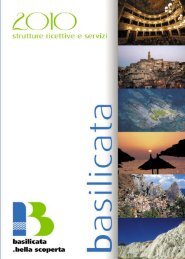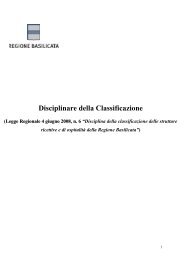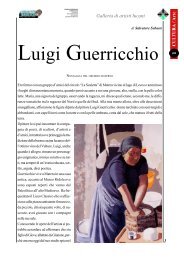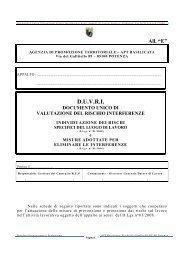Archeonaut - APT Basilicata
Archeonaut - APT Basilicata
Archeonaut - APT Basilicata
- No tags were found...
You also want an ePaper? Increase the reach of your titles
YUMPU automatically turns print PDFs into web optimized ePapers that Google loves.
olicoroiris HerakleiaAristotle relates in his Politics that itwas Italus, the descendant of Oenotrius,who transformed the Oenotrian peoplefrom nomadic shepherds to experts incultivating the land and tending vines(oinos= vine), also giving them therudiments of laws and institutions.Fertile lands, an abundance of waterand proximity to the sea favoured rapiddevelopment, earlier than that of thecoastal inhabitants, following those ofthe interior.A fortunate encounter led to therefinement of customs and a handcraftspecialisation that can be seen inthe production of pottery, weapons,furnishings, cultic objects and theincreasingly clear emergence of eliteclasses.The indigenous world went intoSiritide Hallcrisis shortly before the birth of theGreek colonies, at the end of the 8thcentury BC. After the first contacts withmerchants arriving from Greece andwith the growing influence of orientaltastes and style, the cultural identity ofthe indigenous people became dilutedalmost to the point of disappearance.The way was paved for the birth ofMagna Graecia. In the late 8th and7th century Greek settlers, alerted bytheir fellow countrymen who had goneahead to reconnoitre, pushed towardsthe area situated between the rivers Siriand Basento on the western coasts ofthe Ionian (the area that was to becomeSiritid) in search of something they didnot have in the mother country: landthat could be cultivated, where theycould settle and employ their variousabilities.I only mix three kraters for the wise:one for health, which they must drink first;the second for love and pleasure;the third for sleep;the fourth is not for us, but belongs to insolence(Banquet of the Learned - Eubolus, 4th century BC)This is how Lycophrones described it,probably because the landscape wassimilar (close to the sea and locatedbetween two rivers) or, according tosome, because Siris, like the country ofPriam, also inexorably disappeared.Siris existed for about a century beforeit was destroyed by the power of Sybaris,which, like Metapontum, was alsofounded by Achaeans.FROM SIRIS TO HERAKLEIAA new colony was found on the remainsof Siris in around 440 BC: Herakleia,or the city sacred to Heracles, thedemi-god venerated by all the Lucanianpeoples for his strength, intelligenceand valour. Herakleia’s innovativeurban plan can still be seen today inthe archaeological park located in thepresent-day commune of Policoro. Itoccupied a rectangular area that wasArchaeological parkSIRIS IS ESTABLISHED, “SIMILAR TO TROY”...divided into the “high city”, or theAcropolis, an intermediary strip and the“low city”.A UNIFORM PLAN, EFFICIENTWORKSHOPSThe most densely inhabited part, whichwas the first one, was crossed by a Plateia,the main arterial road that ran fromeast to west, lined by the various insulaeinto which the blocks were divided.The kerameikos, or craftwork district,was established in Herakleia, with itsown drainage channels, sewer andunderground pipelines. Great quantitiesof ceramics and matrices for makingsmall statues were produced here, ofteninspired by the contemporary Greekschool of Lysippus or the nearer one inTaranto. Iron production was also veryactive: various items can be viewed inthe museum, including an emblematicbust of the god Hephaestus.46 47



